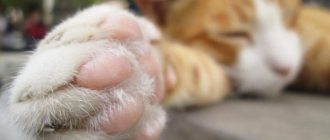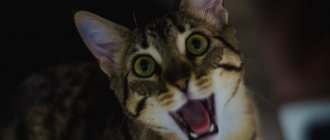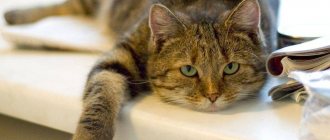11057Administration
2
Sometimes an owner is faced with the fact that his beloved cat is limping on his hind leg. There are many reasons for this phenomenon, and it is important to determine exactly what caused the lameness. A sick animal tries not to put any strain on its paw, almost never steps on it, and falls heavily when walking. The cat stops running, climbing trees, jumping through cabinets because it experiences pain and discomfort when moving and putting stress on the affected limb. It is necessary that the treatment is carried out correctly and the disease does not become chronic. If, in addition to lameness, the owner notices that bald spots are forming between the hind legs, contacting a veterinarian should be urgent. In some cases, lameness is an indicator of an emergency condition.
Sometimes an owner is faced with the fact that his beloved cat is limping on his hind leg. There are many reasons for this phenomenon, and it is important to determine exactly what caused the lameness. A sick animal tries not to put any strain on its paw, almost never steps on it, and falls heavily when walking. The cat stops running, climbing trees, jumping through cabinets because it experiences pain and discomfort when moving and putting stress on the affected limb. It is necessary that the treatment is carried out correctly and the disease does not become chronic. If, in addition to lameness, the owner notices that bald spots are forming between the hind legs, contacting a veterinarian should be urgent. In some cases, lameness is an indicator of an emergency condition.
© shutterstock
Trauma is the most common cause of lameness in cats.
Cats are by nature very active and curious. These qualities often play a cruel joke on them. While examining unfamiliar objects, they can receive various injuries: open injuries to the skin and soft tissues, dislocations, sprains and torn ligaments, bone fractures and joint injuries. If your four-legged pet suddenly becomes lame, the cause of the lameness probably lies in one of the listed problems.
Soft tissue damage
Fights with relatives and contact with sharp objects can lead to damage to soft tissues. This condition, in addition to lameness, is accompanied by bleeding of varying degrees of intensity, redness of surrounding tissues, and acute pain. Traumatic swelling often occurs, which over time turns into purulent inflammation. The appearance of pus poses the greatest danger.
If the wound is deep and extensive, surgery is required. Injuries received within a few hours before contacting a veterinarian are disinfected and closed with a blind suture. If more time has passed since the injury or there are signs of wound infection, treatment includes the use of antibacterial, anti-inflammatory and analgesic veterinary medications.
If you notice that your pet is pressing its front or back paw, you need to examine it. If there is a wound, it should be treated with any available antiseptic and try to stop the bleeding yourself, and then take the animal to the veterinary clinic.
Dislocations, sprains and ligament tears
Cats group well when jumping, trying to land on their paws. However, they are not always able to group correctly, and if the landing is unsuccessful, dislocation or damage to the ligaments is possible. These are rare injuries for felines, but their possibility cannot be completely ruled out. Information about them is presented in the table:
Symptoms of molluscum contagiosum
The incubation period of the disease ranges from two weeks to several months, but most often the rash appears on the 14-15th day.
At first, single rashes appear, then there are more of them. Molluscum contagiosum can affect any area of the skin except the palms and soles. In children, exposed areas of the arms and legs, as well as the face and neck are most often affected. In adults, the genital area and the inner thighs are most often affected.
In the typical form of the disease, the rashes are located only in one anatomical area; in the generalized form, they spread throughout the body.
Rash
The elements of the rash look like protrusions (papules), firm and painless to the touch, pink or flesh-colored, with a pearlescent top. In the center of the papule there is a small depression, from which, when pressed, a white pasty mass is squeezed out. Papules have a round or oval shape, the size usually varies in the range of 2-5 mm, but sometimes the nodules merge, and then such formations can reach a diameter of 1 cm or more.
More about the symptom
Itching
In some cases, the rash is accompanied by itching, which intensifies when scratching. Under no circumstances should papules be scratched, as this can lead to a bacterial infection. The presence of a bacterial infection is indicated by redness of the skin around the papules, swelling, and suppuration.
More about the symptom
Degrees_ that a paw bruise can take in a kitten or an adult cat
Mechanical damage to the limb such as a bruised paw in cats is divided into four degrees:
11th degree. A characteristic feature of bruises is damage to the inner layers of the skin and subcutaneous tissue. A bruise may be accompanied by the formation of a shallow wound such as an abrasion or scratch. Swelling of the injury site and pain are likely. The pain is mild and may be completely absent. Upon examination, you can notice signs of burst blood vessels on the surface of the animal’s skin. A first degree bruise is characterized by rapid healing and does not require complex treatment. Often, with a first-degree bruise, the cat does not limp. 22nd degree. Bruises of this type are accompanied by the formation of hematomas, separation and rupture of muscles. A common sign of injury is swelling caused by the inflammatory process. The animal has an elevated temperature, increased heart rate and breathing, and the cat limps for a long time. 33rd degree. Such bruises pose a real threat not only to the health, but also to the life of the cat. Third degree damage is accompanied by a change in the appearance of the skin. The concept of bruise in this case means damage to muscle tissue, tendons, the formation of fractures and cracks in bones. Along with a 3rd degree bruise, joint dislocation is often noted. When bruised, the animal experiences shock. In the absence of qualified assistance during the first day from the moment of injury, there is a risk of developing tissue necrosis. 44 degree. Mechanical damage to the limbs of the 4th degree is the most dangerous for a cat. Injuries of this complexity are accompanied by crushing of bones and crushing of tissues. Through external damage to the skin, infection enters the animal’s body. Thus, inflammatory and purulent-putrefactive processes occur. The consequence of injury is often an abscess, sepsis and associated negative processes.
Do not neglect qualified veterinary care to avoid potentially dangerous consequences. A kitten's paw bruise is an injury that requires timely attention.
How to detect a bruised paw in kittens and cats?
- The following indicate a bruised paw in a kitten or cat: symptoms:
- The appearance of swelling on the animal's paw. Swelling of the injury site is caused by internal bleeding. While the skin remains intact, blood accumulates inside, causing a characteristic swelling.
- Restless behavior of a pet. When a cat receives a mechanical injury, it feels discomfort and its behavior differs from usual. The pet looks for a “closed” place and hides from the owner, presses its injured paw, does not step on it, and often licks the limb.
- Lameness when walking. In most cases, the cat will noticeably limp due to an injured paw.
- The appearance of external signs of damage. A hematoma, bruise, or lymphatic extravasation is likely to be detected in the area of injury. These signs occur against the background of compression and shaking of internal tissues. There may be an abrasion noticeable to the naked eye, swelling due to inflammation.
In some cases, paw bruises affect internal organs
, osseous-ligamentous apparatus, which provokes the appearance of other symptoms. If you notice that the cat reacts painfully to touching the damaged paw, squeals, or “defends itself” - this is a sufficient reason to contact a veterinarian.
What to do to provide first aid when a kitten has a bruised paw?
“Street” animals accustomed to “wild” conditions can cope with minor bruises on their own
. From this point of view, pets require more involvement from the owner. Even if we are talking about a bruise of the first and second degree, first aid before the arrival of a veterinarian is necessary
.
If the bruise is accompanied by bleeding , try to stop the bleeding and treat the wound. This way you will prevent infection. Be sure to wash your hands. Use gauze pads or a bandage to stop bleeding. The use of cotton wool is not recommended, as particles of the material remain in the wound and cause clogging.
If the bleeding is profuse , it is necessary to apply a special tourniquet or use improvised means. Wrap the material tightly around the edge of the damaged vessel or pinch it with your finger wrapped in a handkerchief. Hold your finger on the wound until a blood clot appears, blocking the bleeding. The artery on the hind leg is pinched from the inside of the thigh, and on the front leg – “above the elbow”.
Be sure to treat the wound to prevent infection. Any disinfectant composition is suitable for this, including hydrogen peroxide or brilliant green. After stopping the bleeding and treating the wound, fix the paw and provide the animal with rest.
These actions are enough to provide first aid to the animal. Next, the owner should immediately contact our veterinary center. Our veterinarians will undertake the diagnosis and determine further treatment to avoid the negative consequences of the bruise.
How to recognize a bruise or injury to the forelimb
An injury or bruise is fairly easy to spot. With such ailments, the animal cannot step on a limb. When trying to touch a sore spot, the cat will remove its paw.
Cat with an injured paw
Animals that are constantly in an active state often suffer bruises on their limbs. Main signs of damage:
- the limb at the site of the injury begins to swell;
- hematoma, which manifests itself even through the fur;
- there are no visible wounds on the injured paw;
- the paw is in its natural state;
- joints are movable;
- the injured area is slightly warmer to the touch than other areas of the body;
- the animal constantly licks the injured limb.
Cat with a bruised front paw
A fracture, unlike a bruise, should be taken much more seriously. Its signs are easier to identify, even without medical education:
- unnatural shape of the damaged paw;
- a broken bone can be easily felt;
- swelling forms on the paw.
Additional Information! Bruises and fractures are characterized by a sudden onset of lameness. Such injuries can result from a simple jump on a chair or windowsill.
This is interesting: What are the infectious diseases in cats?
Why does the animal limp, although there are no visible injuries or obvious causes?
Sometimes it happens that a cat limps from time to time, but there are no visible signs, as well as obvious causes of lameness. In this situation, only a veterinarian can understand why the pet began to limp on the front or back leg. This may be due to diseases of the joints, bone tissue, neoplasms, problems with the spine, and the consequences of infections.
Pretense
Sometimes it happens that the animal has no visible injuries, but the cat still limps on its front leg. The reason in this case may simply be the nature of the animal. A pet whose paw is slightly pinched or, for example, stepped on, may be offended. In this case, the cat, even if it does not feel any discomfort in its paw, begins to limping demonstratively only in order to express its indignation to its owners.
If the lameness is simply emotional, there will most likely be no damage to the animal's paw. Moreover, after a couple of hours the cat will get tired of playing, and he will stop limping.
First aid for a cat
If you notice that your cat is limping, you need to immediately identify the cause. Having discovered a wound, the first thing to do is disinfect it. If possible, remove hair around the damage and rinse with furatsilin solution.
Limit access of dirt to the wound, apply a bandage and contact a veterinarian.
If you suspect a dislocation, sprain or fracture, provide your pet with maximum rest, give painkillers and cardiac medications, and call a doctor.
X-ray of the hind paw.
An x-ray must be taken at the clinic . If necessary, apply a fixing bandage. The fracture is fixed by applying a splint or plaster cast. Antibiotics and anti-inflammatory drugs are used.
Arthritis treatment
Treatment of arthritis includes taking antibiotics in the form of a dietary supplement - glucosamine, chondroitin.
Taking fish oil and painkillers. A light massage and daily short exercise are indicated. Animals with arthrosis are provided with dietary nutrition and comfortable living conditions.
Drug treatment - decongestants, anti-inflammatory drugs - in the presence of inflammation. Massage, Minin lamp therapy. For severe back injuries, the prognosis is, unfortunately, unfavorable. The animal experiences severe pain, and sometimes limb paralysis is observed.
Care and maintenance
After surgery, it is necessary to limit your pet's movement to relieve stress on the damaged limb. This restriction may not be long or may last about six weeks for complex fractures.
Sometimes a doctor may apply a plaster cast, splint, or soft bandage for limping. They must remain clean and dry. They need to be checked every day to avoid swelling, diaper rash or pain.
Follow all directions from your veterinarian and ensure your pet is taking regular antibiotics or anti-inflammatory medications. Repeat x-rays may be necessary, as well as a visit to the veterinarian.
Remember, you should immediately contact a veterinarian if you notice lameness in your pet in order to solve this problem and not lead to irreversible processes.
A healthy cat is an active animal; it still lives exclusively at home or goes out for a free walk. Such activity can lead to a number of injuries, for example, lameness on the front leg. Often this is not an independent disease, but a clear symptom of the presence of other hidden diseases.
What is it - lameness or a fracture of the front paw?
Everything greatly depends on the health status of the particular pet, the severity of the individual episode, most often the signs are as follows:
- the animal does not step on the sore leg, tries to transfer weight to the healthy limb;
- the cat has an uneven, slow gait;
- does not want to perform the movements that are familiar to her;
- the pet does not allow anyone to touch its sore paw and is in pain;
- The cat endlessly licks the sore limb.
Arthritis treatment
Therapy for arthritis involves the use of antibiotics, as well as dietary supplements, such as chondroitin or glucosamine. The pet is also advised to take painkillers and fish oil. For arthritis, the doctor prescribes a light massage, the most comfortable conditions for the sick animal, and a diet.
Medications include anti-inflammatory (if necessary) and decongestant drugs. Therapy using a Minin lamp is useful for cats. Severe, neglected situations often have a disastrous outcome: the pet suffers from severe pain, and the injured limb is sometimes paralyzed.
What to do if your cat has a sore paw and is limping
If it is not a tiny wound, not a slight bruise, but long-term lameness, the animal must be shown to a specialist. Elementary inattention, negligent attitude towards the health of a pet and attempts to treat lameness on your own often lead to complications, even disability, since it is impossible to make an accurate diagnosis without a medical education. In most cases, X-rays and tests are required. Only based on the results of a complete examination, an injured area or disease requiring medical treatment is identified.
Important! Many dangerous diseases that cause lameness can only be treated surgically. In any case, only a doctor can identify the disease and prescribe treatment.
Prevention of arthritis, arthrosis, vitamin deficiency
Diagnostics
Neither successful treatment nor a reasonable prognosis for the affected cat is possible without an accurately established diagnosis.
Clinical examination
On the examination table, the doctor examines and carefully palpates the injured animal. Particular attention is paid to the preservation or absence of motor reflexes and pain sensitivity. Already at this stage, it is possible to approximately assess the location and extent of damage to the spinal cord.
Severe fractures of the spine are visible to the naked eye (back deformation, unnatural body position), but the doctor always sends a cat suspected of such a diagnosis for an x-ray examination.
X-ray
The good thing about X-rays is that the images can be taken without anesthesia and quickly provide additional information about the injury. Digital X-rays are not available everywhere, but not a single decent veterinary clinic can do without a conventional device.
The images will show tumors, fractures and vertebral displacements. In case of severe injuries, based on X-rays, it can be confirmed that the spinal cord is ruptured (a combination of fracture and dislocation of the spine). However, the nerve substance itself cannot be seen on an x-ray. Therefore, if the owners are ready for surgery and want to do everything possible, the cat will have to undergo a special diagnosis.
Contrast myelography
To make the spinal canal visible on x-rays and determine the location of its compression, a contrast agent is injected between the membranes of the spinal cord. The pet must be under anesthesia. After contrast is administered, a series of x-rays are taken at regular intervals.
The advantage of such research is its wide availability (no special equipment is required) and information content. However, compared to CT or MRI, myelography is more dangerous because it is an invasive diagnostic method. In 1-2 animals out of 100, it causes complications associated with increased intracranial pressure or accidental damage to a vessel with a needle and the formation of a hematoma.
Magnetic resonance imaging (MRI)
The gold standard for diagnosis for any spinal injuries is MRI, as it makes it possible to see in detail the nervous tissue of the spinal cord, the area and degree of damage, and compression. This study is performed under general anesthesia. An MRI should precede all spinal surgery (and helps determine whether such surgery is advisable at all).
How to distinguish a fracture from a bruise on the hind leg
The cat limps on its hind leg without visible damage due to fractures, cracks in the bones, sprains, dislocations, or severe bruises. At the same time, it is completely impossible to distinguish a fracture from a crack at home.
A pet can limp for a variety of reasons.
With fractures and cracks in the bone, the pet does not lean on the sore paw at all, but constantly holds it suspended. Tries to move less. When trying to examine, he does not allow you to touch the sore limb. Swelling and increased temperature may be observed at the site of injury.
As first aid, the limb must be immobilized by applying a cardboard splint and securing it with a bandage. Trying not to disturb the sore paw, you need to take the cat to the veterinary clinic. After an x-ray and a detailed examination, specialists will apply a plaster cast or splint, depending on the severity of the injury.
An x-ray will show the presence of a fracture
Unlike a fracture, with bruises, the cat sometimes leans on the damaged paw, even if there is some swelling. When palpated, the injured limb causes pain. After 1-2 days, the ward will begin to rely on her more and more often. Soon the lameness will completely go away.
Providing first aid for a concussion in a pet
If the cat received a blow to the head area and there is a suspicion that she has a concussion, then you need to bring her into a room with dim lights and put her down. If the symptoms do not disappear within ten minutes, then you should definitely seek advice from a specialist. Large cities usually have a 24-hour veterinary clinic.
In case of loss of consciousness, you must follow the following algorithm:
- do not try to stir up the animal or lay it on its side;
- in case of tongue retraction, ensure its straightening;
- Apply dry cold to the injury site;
- make a cold compress on the head (wet a towel in cold water, fold it several times and place it on the animal’s head);
- if there is an open wound, you need to stop the bleeding and apply a bandage;
- if vomiting begins, make sure that the cat does not choke on the mass;
- in case of cessation of breathing, it is recommended to perform indirect cardiac massage and artificial respiration.
Among the drugs that can be used without consulting a doctor, use an injection of caffeine and camphor. But it’s better not to treat a cat’s concussion on your own. The symptoms should prompt you to see a specialist.
Consequences of a fall
The consequences of a fall can only be stress and bruises, but there can also be fractures and internal bleeding or instant death. It depends on your luck. If a cat falls on the grass or in a snowdrift, it has a better chance of surviving. If on asphalt, prepare for the worst.
Elena: “We didn’t have a metal mesh before, or even a mosquito net. The cat was not allowed on the balcony, but she still made her way there from time to time. I really loved walking on metal clothesline holders. But everything always ended well. And then they overlooked it: and the cat fell from the 3rd floor. We didn't notice her absence for a couple of hours, because... she always loved to hide and sleep somewhere. But after 2 hours they became worried: the cat was nowhere to be found. Then the thought arose that she had fallen. I went under the windows to look. Screamed her name. And then I hear the cat’s “Meow!” I look, and my six-month-old baby is sitting in the basement window and calling me. As soon as I went to her, she rushed towards me and grabbed me with her paws, releasing her claws, as if she was afraid that I would let her go. She waited for me for 2 hours! Afterwards, at home, she peed blood several times. But after that everything returned to normal. The cat lived for 18 years and died of old age. We were very lucky that she was strong and resilient! What’s most interesting is that after that we moved to the 6th floor, under supervision the cat was allowed to sit on the bedside table near the open window - she never tried to jump down, because that lesson was enough for her for the rest of her life.”
The editors of the MURKOTIKI website would like to point out that this is just an isolated example. Many cats do not learn from their mistakes and after a fall, no matter how serious, may not be afraid of heights and fall again. So it’s worth taking preventative measures in any case.
What should the owner do
In case of an open abdominal injury, it is necessary to close the wound with a dense fixing material and urgently call for veterinary help. In case of internal injuries, it is recommended to apply dry cold to the peritoneum and immediately use the services of doctors.
We will help your cat
If you suspect that your pet has suffered an abdominal injury, contact our clinic immediately. We will receive a small patient in offices equipped with modern equipment, or we will come to your home. The veterinarian will conduct an initial examination, provide emergency assistance, perform tests, a comprehensive examination, recommend a course of treatment for the consequences of the injury, and, if necessary, perform surgical intervention. Do not be afraid to entrust the life of your pet to our caring and experienced doctors.
A joint is a complex mechanism that has several “safeties”, ligaments are one of them. A cat sprain is a fairly rare injury, although it only takes one awkward movement to cause one. Striped animals are protected by their natural plasticity, but with metabolic disorders or a lack of microelements, flexible connective tissues “coarse.” In addition, sprains are difficult to diagnose, or rather, to identify based on “vague” symptoms.
Dense fibrous connective tissue, consisting of many fibers, is almost always in “tension” (a tense state). The following types of ligaments are distinguished in the animal’s body:
- Strengthening
– envelop the joint from the front side, limit the angle of flexion of the joint.
- Inhibitory
– connect the bones on the back side of the joint, limit the angle of extension of the limb.
- Guides
– set the amplitude and angle of joint movement.
- Fixing
– hold the internal organs in a physiologically correct position.
When we talk about sprains, we mean injuries to the ligaments of the joint capsules of the limbs. The ligaments that hold the internal organs are also stretched, for example, when falling from a great height and hitting the ground. Connective tissues are literally permeated with nerve endings, so violation of the integrity of the ligaments is always associated with severe pain.
For convenience, ligament injuries were divided into sprains and ruptures. However, in both cases the pain is associated with rupture of the fibers, in the first case the damage is partial, in the second the ligament is completely separated. With a favorable combination of circumstances and timely assistance, fibrous tissue grows together quickly and without medical intervention. The worst-case scenario is hemorrhage into the soft tissues due to increased local pressure.
Prevention of lameness
To prevent lameness due to insufficiency of vitamins and microelements, the development of arthritis, and arthrosis, the cat’s diet must be balanced. If you use dry food, then only high-quality industrial food. Before purchasing, you should carefully read the ingredients. It is necessary to limit the consumption of canned food, fatty foods, flour products, and also add more boiled vegetables.
Only a veterinarian can prescribe vitamins. Many four-legged felines are allergic to them.
Whatever the cause of lameness, it causes discomfort and pain to the patient. Trying to treat it yourself means wasting time. What if this is a serious disease that requires urgent surgical intervention? It is not at all difficult to show your pet to a specialist, thereby preserving his health, and in some cases, his life.
Why does this happen?
The cause of a concussion in outdoor cats can be a fall from a height, being hit by a car on the road, an awkward jump from a tree, or being hit by a person.
Domestic cats get it as a result of heavy objects falling on them or hitting a wall if the animal is scared or does not have time to brake in time. A concussion is accompanied by cerebrovascular accident and sometimes hemorrhage. This process results in disruption (temporary or permanent) of normal brain activity and activity.
First of all, you need to call a veterinarian. An experienced doctor will provide immediate assistance to the animal.
Molluscum contagiosum in children
Molluscum contagiosum is more common in children than in adults. Children up to one year old practically do not get sick with molluscum contagiosum. This is due to the fact that in the first year of life the child’s circle of contacts is small: the child moves in a limited space, often specially prepared for him and under the strict supervision of adults, without trying to come into contact with other children. But as soon as a child begins to actively communicate and independently explore the world, the threat of becoming infected with molluscum contagiosum increases sharply.
The peak incidence of molluscum contagiosum in children occurs between the ages of 2 and 6 years. Immunity at this age is still weak. Children become infected through toys or dirty hands. The virus penetrates the skin in the place where the integrity of the skin is damaged - through wounds, abrasions, cracks. Children's skin is delicate and sensitive, and the activity of a preschool child is great. As a result, numerous microtraumas occur, opening the way for infection. Cases of infection with molluscum contagiosum while swimming in the pool have also been described.
From 6 to 10 years, the incidence of molluscum contagiosum decreases. Instilling household hygiene skills is of great importance. The sooner your child starts taking care of clean hands, the better.
Back or brain injury and their consequences
The cat has a swollen paw and is limping: what to do?
Unfortunately, more severe injuries resulting from cats falling from a great height (from a balcony, roof) are fraught with bruises, concussion of the brain and spinal cord with subsequent neurological disorders. In addition, they may be accompanied by numerous fractures of the musculoskeletal system.
For your information! A strong blow to the head leads to the destruction of brain cells, and the hypothalamus and brain stem may be damaged. In especially severe cases, cerebral hemorrhages and tissue necrosis occur.
When the spinal cord is contused, a disruption in the functioning of the musculoskeletal system occurs, the animal limps or completely loses the ability to move. Vomiting occurs, the pupils often have different sizes, and they react poorly or not at all to light. The cat begins to spontaneously shake its limbs. The head may fall back, and the pet may lose consciousness or fall into a coma.
Important! The cat's symptoms and behavior depend on how severely the animal is injured. In severe forms with rupture of the spinal cord membranes, the sensitivity of the limbs and tail is completely lost.
If the cat is unconscious or in shock, under no circumstances should you shake it or apply ammonia to its nose. You need to make sure that the tongue is not stuck and take it to the veterinarian in your arms. Only a specialist can assess the degree of concussion. Depending on the situation, he will give the necessary injections of antibiotics and sedatives. In some cases, the use of medications to support heart function will be required. The doctor will give the necessary recommendations for care and treatment. The recovery of a cat is long, up to 4-8 weeks or more (depending on the age of the animal and the severity of the condition).
The presence of serious diseases that cause lameness can only be detected by a veterinarian
What are the symptoms of serious injury after a fall?
A visual inspection will tell you what injuries the cat received when it fell:
- if she lies motionless, most likely she has a spinal fracture;
- failure of the hind legs indicates damage to the pelvic bones;
- curvature of the limbs and lameness will indicate dislocations or fractures;
- vomiting and disorientation may suggest a concussion;
- heavy breathing will reveal a lung bruise;
- drooling and an open mouth are signs of a jaw fracture;
- an enlarged, painful abdomen combined with bleeding from the nose, mouth or anus indicates serious injury to internal organs;
- shallow breathing, pale mucous membranes, weak pulse suggest traumatic shock;
- blood in the urine will indicate a kidney injury.
If no visible damage is found, do not rush to relax. Alarming symptoms may appear later. Among them:
- drowsiness;
- aggression;
- decreased appetite;
- spitting out food;
- increased salivation;
- breathing problems due to diaphragmatic hernia;
- unsteady gait;
- reluctance to step on paws;
- forced poses;
- lack of urination (more than a day) and defecation (more than two days).
Once I saw a neighbor's cat fall from a 5th floor window. She landed, was in a stupor for several seconds, and then flew away in an unknown direction. This behavior does not at all mean that the animal remained safe and sound. The release of adrenaline into the blood from the resulting stress could temporarily dull the pain, and serious consequences would appear a little later. Unfortunately, nothing is known about the further fate of this cat.
If a cat falls, it can suffer internal injuries that are invisible to the eye, so in any case it is important to show it to a qualified veterinarian.
Lameness with stomach pain
A common cause of lameness is stomach pain. Prolonged constipation, inflammation of the gastric mucosa or intestinal obstruction are all dangerous pathologies that require an urgent visit to the veterinarian.
With constipation and intestinal obstruction, hard feces can cause short-term paresis and paralysis. If a cat behaves lethargically, refuses food and water, drags its paws, or does not want to move at all, the only thing a loving owner can do is take the animal to the clinic. It is strictly forbidden to force feed your pet or try to give the cat any medications to normalize digestion.
Internal diseases
Sometimes the causes of “dragging” of one or two hind legs can be a consequence of internal pathologies.
Physiological fractures
Bone tissue may lose its strength and elasticity. Even slight pressure on a bone can cause it to fracture. The problem occurs due to:
- improperly selected diet;
- lack of vitamins and minerals;
- excess phosphorus, vitamins A and D, fluorine, magnesium;
- renal failure;
- thyroid diseases;
- pathologies of the digestive system;
- breed predisposition.
Siamese, Scottish, British and Sphynx cats suffer from hyperparathyroidism more than others.
Arthritis or arthrosis
Disease of the hip joints can be localized on one side or both. The animal begins to limp gradually. But the characteristic “wiggle” of the rear when moving is becoming more and more noticeable. The problem often occurs in elderly individuals. But the disease can also affect young cats if they have suffered trauma to the pelvic area in the past. Treatment involves significantly slowing the progression of the disease. It is impossible to completely recover from such an illness.
Joint diseases
Also, without visible damage, the cat limps on its hind leg with serious joint diseases. Some of them are congenital and therefore develop slowly. Pathology cannot be detected by a simple examination without medical education. If you pay attention to the accompanying symptoms and promptly contact specialists, the animal can be cured without resorting to surgery.
- Hip dysplasia is a genetic disease. It is dangerous because it can progress even in young cats. Lameness is especially noticeable after prolonged rest (sleep, rest).
- Arthritis and arthrosis are common in older animals. The disease affects bone tissue, causing pathological changes. Due to pain, cats try to move as little as possible, preferring to lie down. They often refuse food and become weak. When palpating swollen joints, they react sharply to pain. The disease may be accompanied by fever.
- Patella patellar luxation, or patellar luxation, is an uncommon problem in cats. It is usually the result of severe trauma, or less commonly a genetic abnormality. It occurs suddenly, causing severe pain in the animal. At the slightest movement of its paw, the cat meows loudly. The injury requires immediate treatment, and in advanced cases, surgery.
Lack of calcium affects the motor functions of kittens
- Osteomyelitis is a disease that occurs in young cats during the phase of active growth and development. Degeneration and partial destruction of bone tissue can affect not only one limb, but all at once. The disease is characterized by acute pain in the pet, which is why even light touches cause aggressive behavior.
- Osteochondrosis, in which pinching and compression of the nerve roots in the spine occurs, causes the animal to limp in any of the four limbs. Wear of the cartilage layer of the intervertebral discs affects the cat’s ability to move easily.
- Osteosarcoma is a malignant neoplasm. Usually it is a pathology of older cats that have crossed the 6-7 year mark.
All of these diseases can only be diagnosed by a doctor at a specialized clinic. They require mandatory treatment with corticosteroids, immunostimulating and painkillers under the supervision of a veterinarian. In severe cases - surgical intervention.
Important! If there is any suspicion of joint disease in cats, you must immediately take your pet to the clinic. Delay or attempts at treatment at home can negatively affect his health and lead to death.
Operation for advanced cases
After receiving an injury, the dislocation must be corrected as soon as possible. Delay in receiving medical help leads to muscle contraction, the formation of a dense blood clot and scar tissue. These changes make it difficult to reduce the dislocation using a closed method. In such cases, the question arises about surgical treatment of advanced dislocations.
During the operation, during which the animal is asleep, an incision is made in the joint area, through which fibrin clots and destroyed parts of the joint are removed. The joint returns to its original position; this will require force or special levers. A joint reduced openly also requires fixation and temporary immobilization.
DETAILS: Biceps tear - SportWiki encyclopedia
Sometimes a cat requires surgical fixation of a joint:
- for dislocations of the hip or wrist joints, it is carried out using special pins;
- for elbow and ankle - screws and wires.
Congenital dislocations in furry pets are usually eliminated using the open method. After a minor dislocation, the animal recovers within 3-4 days. The cat can use its paw, but has a slight limp. Full recovery from severe dislocations takes about 3-4 weeks.
In the best case, the entire injury will be reduced to micro-tears of the ligament fibers and will not require specific treatment, you just need to provide the pet with rest and care. Connective tissues quickly regenerate and your pet will come to its senses within 2–3 days.
If you are “lucky” and the sprain is associated with a dislocation of a joint or a broken bone, you will need the help of a doctor, and immediately. The damaged bone is set, and a fixing bandage or plaster is applied to the limb.
Achilles tendon rupture in dogs and cats
Rupture of the Achilles tendon (Rupturatendinis achillis) can occur as a result of an accidental cut or chopped-torn wound (wild boar tusk), as well as from a strong blow with the hoof of an elk or other domestic ungulates, when hit by moving vehicles, etc.
Clinical signs of a complete rupture of this tendon are characterized by flexion of the limb at the metatarsal joint and support of the entire plantar surface of the metatarsus on the ground. The movement is difficult and occurs on three limbs; with each attempt to lean on it, the affected limb bends sharply at the tarsal joint. The dog's croup is drooping, and a wound or depression forms in the area of the Achilles tendon (with a closed injury).
In case of incomplete rupture, flexion of the joint during support occurs gradually (slowly), as if the limb cannot withstand the weight of the body. In subsequent days, due to contraction of the calf muscle, an incomplete tear may become complete.
The forecast is cautious. Cases of spontaneous restoration of the anatomical continuity of a damaged joint due to the formation of a connective tissue scar have been described. However, complete restoration of limb function may not occur due to incorrect (at a considerable distance) connection with a scar. Various complications are also possible in cases of the development of purulent infection with tendon wounds (tendon necrosis, tenosynovitis).











